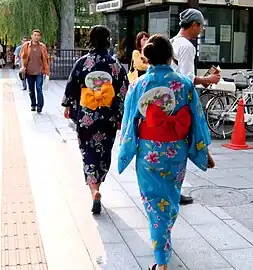 Men's and women's yukata | |
| Type | Casual summer kimono |
|---|---|
| Place of origin | Japan |
A yukata (浴衣, lit. 'bathrobe') is an unlined cotton summer kimono,[1] worn in casual settings such as summer festivals and to nearby bathhouses. The name is translated literally as "bathing cloth" and yukata originally were worn as bathrobes; their modern use is much broader, and are a common sight in Japan during summer. Though yukata are traditionally indigo and white in colour, modern yukata commonly feature multicoloured designs, and are designed to be machine washable. They are similar in appearance to the nemaki, a unisex short-sleeved kimono-like garment worn by guests at traditional inns.
Construction and wear
Yukata are worn by men and women. Like other forms of traditional Japanese clothing, yukata are made with straight seams and wide sleeves. Men's yukata are distinguished by the shorter sleeve extension of approximately 10 centimetres (3.9 in) from the armpit seam, compared to the longer 20 centimetres (7.9 in) sleeve extension in women's yukata. A standard yukata ensemble consists of a yukata obi, and sandals or geta worn without socks. The outfit may be accessorised with a foldable or fixed hand fan and the addition of a traditional carry bag known as a kinchaku, used by both men and women to carry cellphones and other small personal items.
As with all kimono, the left side of the yukata is wrapped over the right side, and secured with either a stiff, one-layer obi, or a softer, also one-layer obi. An outer jacket may be added for cool weather.[1]
Traditionally, yukata were mostly made of indigo-dyed cotton; however, following an increase in popularity in the late 1990s, a wide variety of colours and designs are now available, worn by both men and women.[1]
Customs
.jpg.webp) A family in yukata in an onsen town
A family in yukata in an onsen town A Japanese lady wearing a yukata
A Japanese lady wearing a yukata Women in yukata
Women in yukata.jpg.webp)
 Endō Shimpei, 1887 woodblock print by Tsukioka Yoshitoshi
Endō Shimpei, 1887 woodblock print by Tsukioka Yoshitoshi_with_Illustrations_from_the_1802_novel_'Hizakurige'_(Shank's_Mare)_by_Ikku_Jipensha_(1765-1831)_LACMA_M.2006.37.6_(5_of_9).jpg.webp)
Though historically, yukata were worn traditionally as a bathrobe all-year round, in the present day this is uncommonly seen, and is mainly confined to onsen resort towns such as Atami, Kinosaki and Kusatsu, where yukata are still worn as bathrobes, commonly gifted to guests as part of their stay at a specific hotel or inn.[2][3]
See also
References
- 1 2 3 "Yukata". www.japan-guide.com. Archived from the original on 2017-09-20. Retrieved 2018-04-26.
- ↑ "How to Wear a Yukata". Visit Kinosaki. 2018-03-22. Retrieved 2018-10-18.
- ↑ "How to Stay at a Ryokan: Dress (Yukata)". www.japan-guide.com. Retrieved 2018-10-17.
